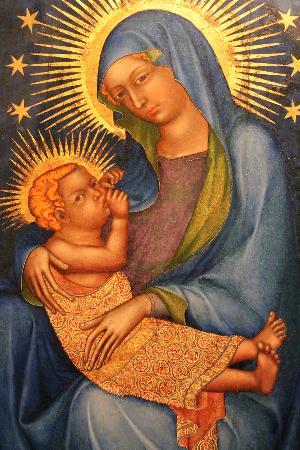
The first day in another country overloads the senses. A jet-lagged body soaks in stimuli like a sponge: an omni-present odor of lemon grass in the hotel, people’s faces, puff jackets with hoods rimmed in fur, the raw edges of early spring, the cobbled streets, a profusion of Baroque, patterns of signage – and hopefully, the traffic patterns.
In Prague pedestrians have the right of way, but trams trump everything. “Pozor!” means look out – and should be taken seriously. Brown arrows with white letters point out historical monuments, but it takes a while to figure out which. At first pass, the Czech language looks like a jumble of consonants with lots of inflections and a predominance of v’s and j’s, z’s and c’s.
It’s a lot to take in. We walked enough to get down basic bearings. Then, jostled and over-stimulated, we repaired to the slower cadences of the St. Agnes Convent and Museum.
Royal blood coursed through the veins of Agnes of Bohemia (1211-1282), and her parents sought a marriage of advantage. Engaged first to Henry, son of the Holy Roman Emperor Frederick II, Agnes was packed off to imperial court, only to have that union thwarted by a local duke who wanted to wed his own daughter to the emperor’s son. Henry III of England emerged as a potential mate, but the emperor challenged the union. He wanted to wed Agnes himself.
At this point, Agnes intervened, choosing for herself a life of prayer. To safeguard the plan, she secured consent of the pope and land from her brother.
Along the Vltava River, her convent now houses a stunning collection of medieval religious panels and statuary, many devoted to Christ and his mother. In most of these, Christ is an infant, nestled in the arms of his mother and nursing at her breast. As Margaret Miles argues in A Complex Delight (University of California, 2008), early medieval religious art featured the infant Jesus, not the dying Christ. A nurturant mother, not a dying man, captured the medieval imagination.
Over and over again, in icons and statuary and paintings, we gazed on a child, latched onto the breast of his mother, nursing so eagerly we could almost hear him sucking. And on the face of the mother, a smile of infinite peace.
That smile blocked out the blast of the trams, the bustling of the streets, the riot of Baroque.
I held that smile with me for the rest of the visit: it was our first blessing.
No comments:
Post a Comment